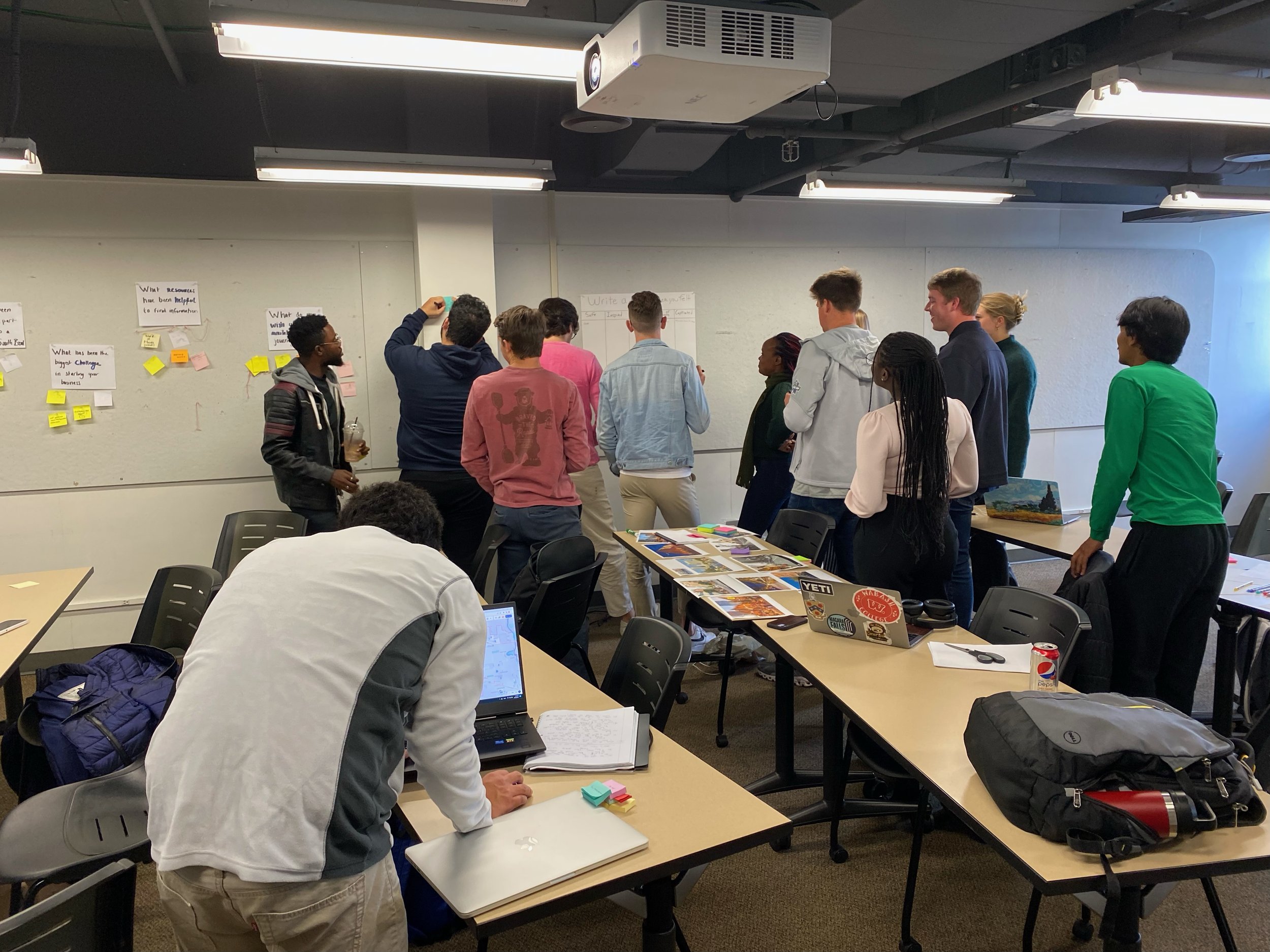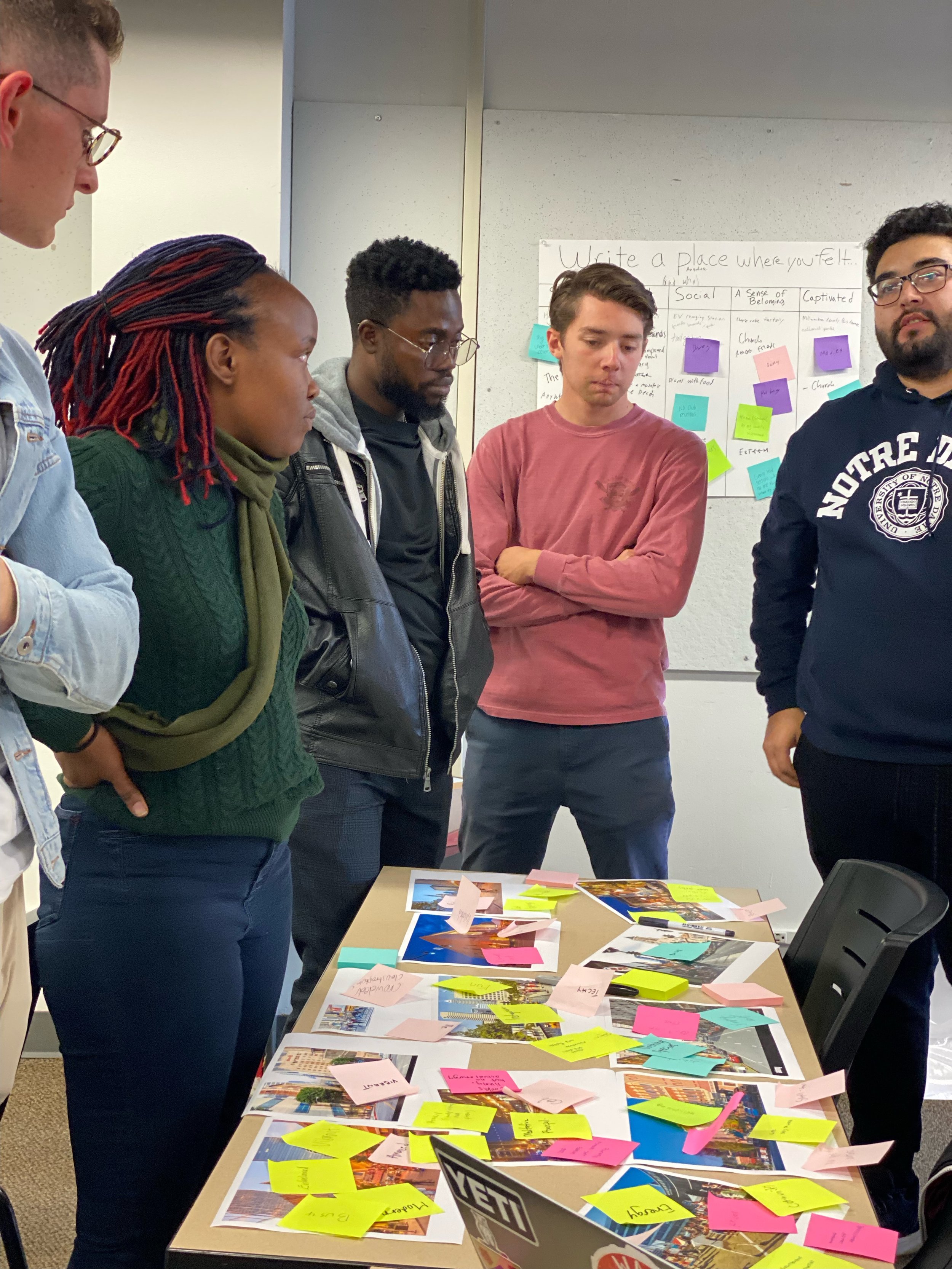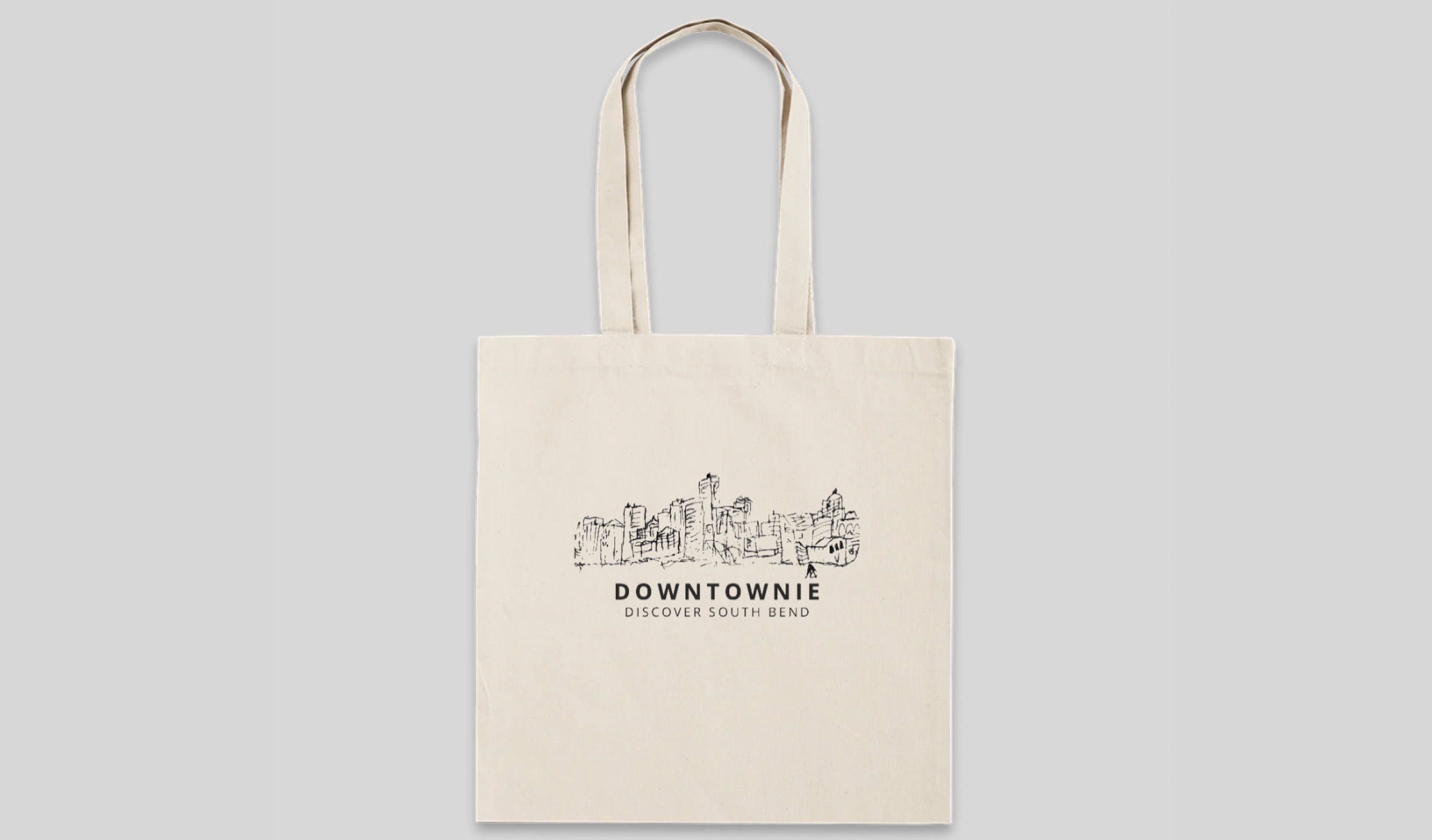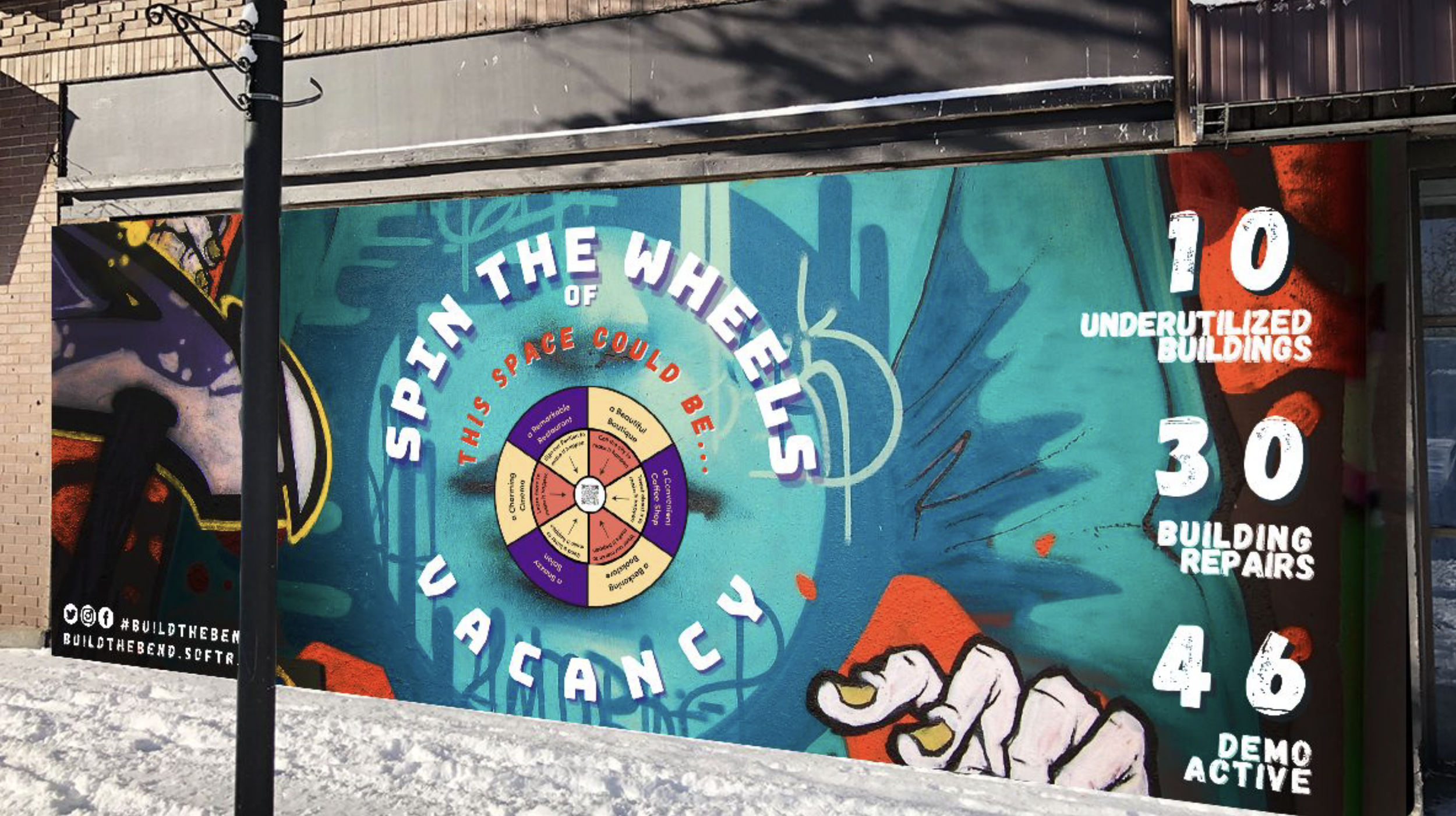Teaching Sample
Collaborative Design
Course Overview
In this cross-disciplinary course we partnered with the nonprofit Downtown South Bend (DTSB). Their main objective is to make downtown South Bend a destination city that is liveable, loveable, and walkable. DTSB confers with current and/or new businesses, on a daily basis, who are struggling to navigate the inconsistent business processes of downtown South Bend. Despite this, entrepreneurs and DTSB still have a gap in understanding about what the path is to ownership and operation. DTSB is excited to partner with us and hear our insights and ideas to create positive change for business owners in downtown South Bend.
Teams developed innovative solutions through an association of expertise from business, sociology, science, engineering, psychology, anthropology, industrial design students and faculty. Collaborating teams of undergraduate and graduate students applied a Design Thinking Mindset and a Human-Centered approach combined with appropriate methodologies originating from participating students’ primary field of study.
The course will have three primary procedural cycles, 1: Understand 2: Explore 3: Materialize. The team project should conclude with the development and presentation of a comprehensive proof of concept and a contextually resolved solution clearly based upon research conducted during this course. All team members will collaborate throughout the three procedural cycles.
Objectives
Students should leave this course inspired and capable of approaching collaborative opportunity finding and problem-solving in a structured manner to solve problems across a wide spectrum of industries and initiatives. Furthermore, students should possess the creative confidence to apply divergent thinking and push beyond obvious, low hanging fruit solutions. Upon successful completion of this course, a student will have demonstrated the ability to:
Understand various phases of the design process in a collaborative multi-disciplined environment through an iterative and systematic approach.
Apply design-thinking strategies to evaluate, conceptualize and synthesize “integrated” design proposals.
Develop an integrative approach to identify opportunities and create design proposals that combine seemingly disparate design disciplines into a unified and comprehensive design solution.
Identify project scope and design objectives and methodically plan for its execution; (this includes the development of a design brief and strategy, generating design concepts, and creating design prototypes)
Construct a design solution (i.e., a service, product, environment, information) from a human-centered, holistic approach focusing on user interactions and overall experience.
Communicate preliminary studies and final design proposals verbally and visually in 2-dimensional, 3-dimensional and/or time-based prototypes.
Phase One: Understand
Getting to Know the Downtown South Bend Business Scene
The primary objective of phase 1 was to identify a specific research question within the larger topic of business processes in downtown South Bend and design a research plan to conduct in phase 2. Successful research questions needed to be broad enough to leave room for insights, yet focused enough to be able to create a research plan to address the topic.
Students began with individual, secondary research to begin their understanding of the research question . They then developed a specific research question that they wanted explore for the rest of the course. Students presented their questions to the class, and then created teams around a few key questions. Teams worked together to execute the research and design process for the remainder of the semester.
Their research plans should empower them to uncover insights and build empathy around their research topics. Research plans had to include ethnographic interviews and two additional research tools. Student-led teams used this introductory information to create preliminary user personas, journey maps, and scenarios.
Phase 1 will end with a compelling, visual presentation that thoughtfully communicates what you’ve learned and what you hope to learn through your upcoming research. Their job was to convince the audience that the questions are worth understanding.
Learning Objectives for Phase 1:
Why research matters
The importance of empathy
How to discover and define a successful research question
How to conduct secondary research
Understand the difference between qualitative and quantitative research
How to build personas, journey maps and scenarios
How to choose which design research tool is best for your research goals
How to write a research plan
Project Two: Explore & Ideate
Understanding Behaviors to Uncover Needs, Aspirations, & Opportunities
Based on your phase 1 question and findings they began writing ethnographic interview questions and preparing to conduct their research plan. As a trial run, each team will conducted a research activity with the class that includes their toolkit. The goals of their ethnographic interviews and research activities were to understand the perceptions, emotions, drivers, and needs of the target demographic and key factors surrounding the research question.
After analysis students will began the ideation phase where they conducted an in class ideation activity to help propose possible solutions to your research question. Student teams created a phase 2 presentation to present to the team from DTSB and others showing their research process, explaining their findings, and showing their ideation work.
Learning Objectives:
How to conduct design research activities/methods
How to write interview questions, decide who to interview and conduct ethnographic interviews
How to create an affinity diagram
Understand personal bias and preconceived perceptions
How to conduct research techniques in the real world
How to capture data
How to synthesize and analyze data
How to pivot when research does not go according to plan
How to deliver research data
How to turn research into ideation
How to conduct ideation activities
Ideation
How to develop a “How Might We” Question
Project Three: Materialize
In phase 3, they moved from exploration and ideation to prototyping. They created compelling visual narratives to communicate their insights and potential products, services, and/or systems, making explicit connections to the needs, values, and principles identified in phases 1 and 2. The made recommendations on who should be a stakeholder in the project if it were to advance to the next phase. Lastly, they developed a prototype and tested it in the wild.
Learning Objectives:
How to effectively communicate and visualize research findings and insights
How to make recommendations based on key findings
How to prototype
How to test prototypes
Final Projects











